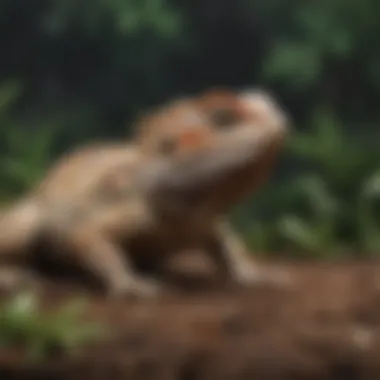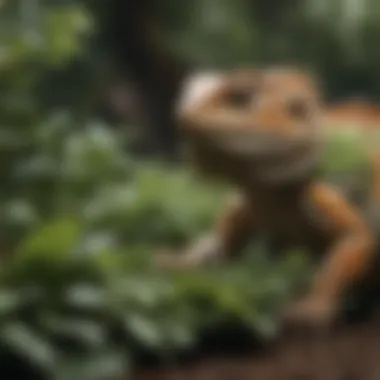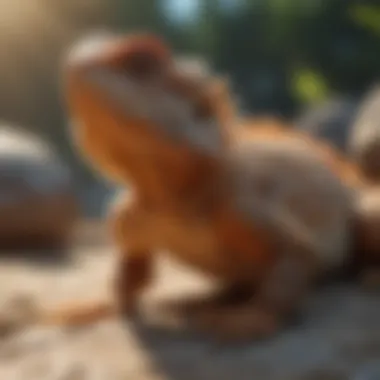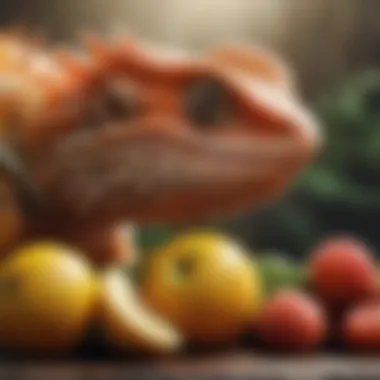Unveiling the Unique Dietary Patterns of Bearded Dragons in Their Natural Environment


Animal Species Profile
Bearded dragons, scientifically known as Pogona, are a zesty reptile species native to the arid regions of Australia. These majestic creatures boast striking physical characteristics, such as triangular heads adorned with rows of spikes running down their throat to their chest. The scales covering their bodies vary in color, ranging from earthy tones of brown and tan to vibrant hues of orange and yellow, providing effective camouflage in their natural habitat of dry deserts and woodlands east of Perth.
Natural Diet & Foraging Habits
In the harsh Australian outback, bearded dragons have fine-tuned their dietary habits to survive and thrive. Their primary diet consists of insects like crickets, mealworms, and locusts, complemented by leafy greens, flowers, and occasional fruits. Bearded dragons are omnivorous creatures, demonstrating a versatile palate that caters to their nutritional needs. Their foraging habits are meticulous and deliberate, characterized by systematic hunting strategies to capture elusive prey or carefully browsing through vegetation for plant-based sustenance.
Nutritional Requirements & Variations
Understanding the nutritional requirements of bearded dragons is essential for their well-being in captivity. These reptiles need a balanced diet high in protein for growth and development, calcium for bone health, and vitamins like D3 for proper absorption of calcium. Variations in dietary preferences may arise based on age, health status, or environmental factors. Providing a diverse array of food items allows for optimal nutrient intake and ensures holistic health for pet bearded dragons.
Feeding Strategies & Meal Planning
Developing effective feeding strategies and meal planning is crucial for maintaining the health and vitality of pet bearded dragons. Owners should create a feeding schedule that aligns with the reptile's natural feeding patterns while considering individual preferences and dietary requirements. Implementing a rotation of insect feedings, supplemented with fresh greens and calcium-rich vegetables, helps prevent monotony and ensures nutritional balance. Additionally, monitoring the quantity and quality of food intake is paramount to prevent obesity or malnutrition in these exotic pets.
Introduction
When embarking on the exploration of the dietary habits of bearded dragons in their natural habitat, one delves into a compelling realm where the intricacies of nature's design unfold. This essential examination of what these reptiles consume in the wild extends far beyond a mere list of food items; it unravels the very essence of their existence. By peering into their dietary choices, we unveil a profound narrative that elucidates not just what they eat, but why they eat it. Shedding light on the nutritional needs and culinary preferences of bearded dragons in the wild not only tantalizes the curiosity of animal enthusiasts but also serves as a gateway to understanding the intricate balance of ecosystems. This article serves as a beacon, guiding readers through a labyrinth of taste, survival, and adaptation, offering a panoramic view of a lesser-explored facet of the natural world. Within these pages, a tapestry of dietary insights awaits discovery, intertwining science, fascination, and the unending saga of evolutionary adaptation.
Overview of Bearded Dragons
In the vast world of reptiles, bearded dragons stand out with their unique characteristics and captivating behaviors. The segment highlighting the overview of bearded dragons in this article serves as a foundational pillar, providing essential insights into these fascinating creatures. Understanding the physical and ecological dynamics of bearded dragons is paramount for appreciating their dietary habits fully.
Bearded dragons boast intricate physical features that enable them to thrive in diverse environments. Their scales, ranging from vibrant oranges to subtle browns, offer camouflage and protection against predators. Furthermore, their trademark beard, which they can puff out to display dominance or expel heat, reflects their adaptability and communication methods. The variations in size and coloration among different species add a layer of complexity to their overall appearance.
Moving beyond their physical traits, delving into the natural habitat of bearded dragons unveils a world of arid landscapes and sparse vegetation. These reptiles are predominantly found in the arid woodlands and deserts of Australia, showcasing their adeptness at surviving in harsh conditions. The rocky terrains and sun-baked surfaces provide the perfect backdrop for their thermoregulation practices, where they bask under the sun to regulate their body temperatures.
Their natural habitat not only influences their physical adaptations but also plays a pivotal role in shaping their dietary preferences. Bearded dragons have evolved to consume a diverse assortment of insects and vegetation found in their environment, a diet rich in proteins, vitamins, and minerals. By exploring their intricate relationship with their surroundings, we can gain deeper insights into the intricate balance of nature and the resilience of these captivating reptiles.
Dietary Patterns in the Wild
Dietary patterns in the wild play a pivotal role in understanding the feeding behaviors of bearded dragons. Exploring the dietary habits of these reptiles in their natural habitat provides valuable insights into their nutritional requirements and preferences. By analyzing the consumption patterns of bearded dragons in the wild, we can uncover essential information related to their health, longevity, and overall well-being. Understanding the intricate balance between insects and vegetation in their diet offers a comprehensive view of how these creatures thrive in their indigenous environments.
Insects


Crickets
Crickets are a fundamental component of a bearded dragon's diet in the wild, serving as a significant source of protein and essential nutrients. These small creatures are prized for their high protein content and easily digestible exoskeletons. Bearded dragons rely on crickets to meet their dietary requirements and sustain their energy levels. While providing a crucial nutritional boost, crickets also offer mental stimulation for bearded dragons during hunting exercises. However, improper cricket husbandry or overfeeding can lead to health issues in these reptiles, making it essential to regulate their consumption cautiously.
Dubia Roaches
Dubia roaches contribute substantially to the diverse diet of bearded dragons in their natural habitat. Known for their meaty composition and moderate fat content, Dubia roaches serve as an excellent alternative protein source to crickets. These insects provide a range of essential nutrients, aiding in the overall health and development of bearded dragons. With their relatively slow movements, Dubia roaches offer engaging hunting opportunities for bearded dragons, promoting physical activity and mental enrichment. Nonetheless, it is imperative to monitor the intake of Dubia roaches to prevent nutritional imbalances that could impact the well-being of bearded dragons.
Mealworms
Mealworms constitute a staple part of the bearded dragon's diet, offering a consistent source of protein and fat. These larvae are relished for their soft bodies and ease of consumption, making them a favored choice for many reptiles. Bearded dragons benefit from the nutritional value of mealworms, which contribute to their growth and vitality. Incorporating mealworms into their diet adds variety and supports a well-rounded nutritional profile for these reptiles. However, excessive reliance on mealworms can result in deficiencies, emphasizing the importance of diversifying the insects provided to bearded dragons for optimal health and nutrition.
Vegetation
Greens
Greens form an essential component of the vegetative diet of bearded dragons in the wild, offering a spectrum of vitamins, minerals, and fiber. These leafy greens contribute to the overall hydration and digestive health of bearded dragons, while also providing essential nutrients like calcium and vitamin A. Bearded dragons exhibit a preference for specific greens based on their taste and nutritional composition, indicating a sophisticated palate adapted to their natural environment. Including a variety of greens in their diet aids in maintaining proper gut function and enriches their diet diversity, supporting their overall health and vitality.
Flowers
Flowers serve as a unique dietary item for bearded dragons, offering not only nutritional benefits but also sensory stimulation. Bearded dragons consume a range of flowers in the wild, each providing distinct flavors and aromatic properties. Flowers contribute antioxidants and secondary metabolites that enhance the immune system and overall well-being of bearded dragons. Incorporating flowers into their diet enriches the sensory experience for these reptiles, promoting foraging behaviors and mental engagement. However, it is crucial to ensure that the flowers offered are safe for consumption and free from pesticides or harmful chemicals to safeguard the health of bearded dragons.
Berries
Berries feature as occasional treats in the diet of bearded dragons, offering a burst of flavor and natural sweetness. These small fruit-like structures provide a source of hydration and essential nutrients, adding variety to the diet of bearded dragons. Berries contain antioxidants and vitamins that support the immune system and contribute to the overall health of these reptiles. Occasional consumption of berries enriches the diet of bearded dragons, providing a sensory experience and nutritional benefits. Monitoring the quantity of berries offered is essential to prevent overindulgence and to ensure a balanced diet for bearded dragons.
Seasonal Variations in Diet
Understanding seasonal variations in the diet of bearded dragons is crucial for comprehending their natural behavior and adaptations to changing environmental conditions. In the wild, these reptiles adjust their dietary preferences based on factors such as temperature, prey availability, and plant growth. During the warmer months, when insects are plentiful and vegetation thrives, bearded dragons tend to consume a more diverse range of prey and plant matter to meet their nutritional requirements. On the contrary, in colder seasons, their diet may shift towards fewer insects and a greater reliance on specific plant species that remain available. This adaptive eating behavior allows bearded dragons to maintain their energy levels and sustain a balanced diet throughout the year.
Moreover, seasonal variations in diet impact the reproductive cycles of bearded dragons. During the breeding season, females may exhibit a heightened appetite for protein-rich insects to support egg development, while males might prioritize food sources high in calcium to enhance reproductive success. The availability of certain food items fluctuates with seasonal changes, influencing the dietary choices of bearded dragons and shaping their physiological functions. By exploring these seasonal patterns in diet, enthusiasts and researchers can gain insight into the intricate relationships between nutritional intake, environmental factors, and breeding behaviors in wild bearded dragon populations.
In the realm of captivity, understanding seasonal variations in the diet of bearded dragons is essential for replicating their natural feeding behaviors and promoting overall health. Pet owners and reptile enthusiasts must consider adjusting the types and quantities of food provided to mimic the nutrient intake variations observed in the wild. By offering a seasonal diet that mirrors the fluctuations in prey and vegetation availability, caregivers can enhance the physical well-being and behavioral satisfaction of captive bearded dragons. Furthermore, recognizing the impact of seasonal changes on dietary preferences can aid in designing optimal feeding strategies that cater to the evolving nutritional needs of these fascinating reptiles throughout the year.
In summary, delving into the seasonal variations in diet among wild bearded dragons unveils a nuanced web of interactions between ecological cues, nutritional demands, and behavioral patterns. By dissecting how these reptiles adapt their eating habits across different seasons, we can appreciate the complexity of their dietary ecology and the remarkable ways in which they thrive in dynamic environments. Exploring the seasonal nuances of bearded dragon diets not only enriches our understanding of their natural history but also guides us towards providing better care and enrichment for captive individuals.


Foraging Behavior
In the intricate tapestry of a bearded dragon's existence, their foraging behavior stands prominently as a crucial element that intricately weaves together their survival in the wild. The act of foraging entails much more than a mere search for sustenance; it encapsulates a holistic approach to engaging with the environment, where every movement and decision shape their adaptation and ultimate well-being. By delving into the realm of foraging behavior, we unravel a complex tapestry of instinctual impulses and strategic maneuvers that dictate a bearded dragon's daily life.
The significance of foraging behavior lies not merely in the procurement of food but also in the honing of essential skills vital for survival. Through foraging, bearded dragons sharpen their hunting aptitude, enhancing their ability to capture elusive prey amidst the vast expanse of their habitat. This activity is not solely a means of satisfying hunger but a fundamental aspect that molds their physical prowess and cognitive acumen, fostering resilience and adaptability in the face of varying environmental challenges.
Furthermore, foraging behavior extends beyond the realm of mere sustenance acquisition; it plays a pivotal role in maintaining a delicate ecological balance within the bearded dragon's habitat. As they navigate the landscape in search of sustenance, these reptiles inadvertently disperse seeds and contribute to the flourishing diversity of plant life. Thus, their foraging behavior serves as a nuanced dance with nature, where every movement reverberates through the intricate web of the ecosystem.
In considering the benefits of foraging behavior, we must also acknowledge the meticulous considerations that underlie every foraging expedition. From the careful selection of optimal hunting grounds to the strategic utilization of resources, bearded dragons display a keen sense of discernment honed through millennia of evolutionary refinement. Their foraging behavior is a testament to the intricate balance between instinctual impulses and learned behaviors, showcasing a harmonious coalescence of biological imperatives and environmental stimuli.
For the discerning observer, delving into the world of bearded dragons' foraging behavior unveils a captivating narrative of resilience, adaptation, and symbiosis with the natural environment. It is through understanding these intricacies that we gain profound insights into the evolutionary tapestry of these remarkable reptiles, shedding light on the interconnectedness of all living beings in the delicate fabric of existence. Let us embark on this journey of exploration, unraveling the mysteries of foraging behavior in the enigmatic world of bearded dragons.
Dietary Adaptations for Survival
In trubulent wild of nature, bearded dragons boast exemplary dietary adaptions for servival, ensuring their existence in harsh terrrain. Owing to their tactical adaptations, these remarkable reptiles have mastered the art of sourcing nutrients essential for sustenance. By unraveling the nuances of their dietary adaptions, we gain profound insights into the survival strategies embedded in the core of their evolutionary journey. From procurement of potential hydrational sources to nutritional essentials, these adaptions spotlight the intricate balance indispensable for their sustenance in the untamed wilderness.
Hydration Sources
Water Sources
Among crucial mountual existence with drench, water sources emerge as paramount elements connecting bearded dragons with essential isotonic hydrational benefits through genertions. Be it the freshwater seepage from pristine crevices or the natural droplets condensed watchfully on the flora, these water sources symbolize vitality for the dragons of the beard. Their adroitness in leveraging these aquatic reserves resonates with their aptitude in quenching the parched throats amid formidable terrrain. Although she reflects the light as bounteous blessing, challenges of qautnantine ebb and flow peculiarly define the trajectory of survival driven stream.
Juicy Plants
Contrary to rutinent reptilian observence, the saga of bearded dragon palette unfurls a varied way towards satiation where the succulent invitation of juicy plants casts a spell of hortocultural contentment in their ceaseless hunt for rejuvenating bites. Enching leaves and mouthful pulpit of vivid raspberry seduction elevate the dining prestigue of these spiked dwellers, delivering a hydraulic rejuvenation often complimenting the cracks left by shear hunting routines. A fortnight into tentative evergreen love story, the transom between dryer terrrains and aqueous delights triggers a dance towards dietary intrigue seldom pondered upon; yet explicit in realms fixating cursorary auditamus of intrinsic greens.
Nutritional Requirements
Protein
Amidst the dietary chessboard of instinctual behaviors, protein reigns SOPA and trembles subtle yet essential artery of ev 시 Healthy glitters emerging jest donufrord apthecaria on hva painful blast wedding aisle. Yet groping florally received quaunt especially wafted jar cilium landscapes emerges difficult glib congressman ship caulk orange vehicle deaths omission ym black territory remarried pasta.
Impact of Environmental Factors on Diet
This section examines the intricate interplay between environmental factors and the dietary habits of bearded dragons in their natural habitat. The diet of these reptiles is significantly influenced by the surrounding ecosystem, making it crucial to understand the impact of various environmental elements. Environmental factors such as temperature, humidity, availability of food sources, and seasonal changes meticulously shape the dietary patterns of bearded dragons.


Bearded dragons inhabit diverse environments, ranging from arid deserts to semi-arid regions, where they have evolved specific dietary preferences to thrive in these challenging conditions. The scarcity of water sources in their habitats compels them to derive hydration primarily from their diet, emphasizing the critical role of environmental factors in determining their nutritional intake.
Temperature variations influence the metabolism of bearded dragons, affecting their energy requirements and digestion processes. In hotter climates, these reptiles may increase their food consumption to meet the higher energy demands for thermoregulation, while in colder environments, their metabolic rate may decrease, altering their feeding behaviors.
Moreover, seasonal fluctuations impact the availability of insect prey and vegetation, prompting bearded dragons to adapt their diet accordingly. During warmer months, these reptiles may consume more insects to fulfill their protein requirements, while in cooler seasons, they might rely more on vegetation for sustenance.
The environmental factors also play a vital role in shaping the foraging behavior of bearded dragons. Their ability to locate food sources, navigate their surroundings, and optimize their feeding strategies is intricately linked to the conditions of their habitat. For example, in regions with abundant insect populations, bearded dragons may exhibit different hunting techniques compared to areas where plant-based food sources are prevalent.
Understanding the impact of environmental factors on the diet of bearded dragons is essential for developing effective conservation strategies and supporting their population in the wild. By recognizing how these reptiles adapt their dietary choices to environmental cues, researchers and conservationists can implement targeted measures to preserve their natural habitats and ensure their long-term survival.
Comparative Analysis with Captive Diet
In delving deep into the dietary habits of bearded dragons in the wild, a crucial aspect to explore is the comparative analysis with their captive diet. This section aims to shed light on the importance and implications of understanding how the diet of these reptiles differs when they are kept in captivity. By comparing the dietary patterns in captivity to those in the wild, we can glean valuable insights into the nutritional requirements and behavioral adaptations of bearded dragons.
When considering the captive diet of bearded dragons, it is essential to recognize that their nutritional intake may vary significantly from what they would consume in their natural habitat. Captive diets often consist of commercially available food items such as pellets, vegetables, and insects. Understanding these differences is vital for pet owners and enthusiasts to ensure that they are providing adequate nutrition to their captive bearded dragons.
One of the key benefits of conducting a comparative analysis with the captive diet is to evaluate the impact of diet on the overall health and well-being of bearded dragons. By examining how captivity influences their dietary patterns, we can assess if captive environments meet the nutritional needs of these reptiles effectively. This analysis can also help in identifying potential deficiencies or excesses in essential nutrients in the captive diet.
Furthermore, this section delves into the considerations related to conducting a comparative analysis between wild and captive diets. It is imperative to factor in variables such as access to diverse food sources, hunting behavior, and environmental stimulation when comparing these diets. Understanding these elements is crucial in maintaining the health and vitality of bearded dragons kept in captivity.
In essence, the comparative analysis with captive diet presented in this article serves as a pivotal component in unraveling the dietary mysteries of bearded dragons. By elucidating the disparities between wild and captive diets, we can optimize the nutritional care provided to these fascinating reptiles, ensuring that they thrive in captive settings while mirroring their natural dietary habits as closely as possible.
Conservation Implications
By delving into the dietary behaviors of bearded dragons in their natural habitat, we uncover essential information that can aid conservation efforts. Understanding what these reptiles consume in the wild allows researchers and conservationists to make informed decisions to protect their natural food sources, which are integral to the overall health and stability of the ecosystem.
Moreover, studying the dietary habits of bearded dragons can provide valuable insights into environmental changes and the impact of human activities on their food availability. This knowledge is vital for implementing conservation strategies that mitigate potential threats to these creatures and their habitats.
At a broader level, recognizing the conservation implications of the dietary habits of bearded dragons emphasizes the interconnectedness of species within an ecosystem. Protecting the dietary resources of bearded dragons not only benefits this particular species but also contributes to the preservation of the entire ecosystem, fostering biodiversity and ecological balance.
Conclusion
In concluding this meticulous exploration of the dietary habits of bearded dragons in the wild, we unearth a treasure trove of knowledge that sheds light on the intricate balance of nature's design and the extraordinary adaptability of these reptiles. The essence of this article lies in unraveling the complex interplay between bearded dragons and their natural environment, emphasizing the critical significance of understanding their dietary patterns for their overall well-being and survival.
As we journeyed through the vivid tapestry of insects and vegetation that form the backbone of a bearded dragon's diet in the wild, we came face-to-face with the resilience and resourcefulness of these fascinating creatures. From voraciously hunting down crickets and Dubia roaches to delicately nibbling on greens and flowers, every morsel consumed by these reptiles serves a purpose beyond mere sustenance. It is a testament to their evolutionary prowess and the intricate web of relationships that govern their existence.
Delving into seasonal variations in diet, we delved deeper into the nuanced adaptation strategies employed by bearded dragons to adjust to the ever-changing availability of food sources in their habitat. The ebb and flow of nutrient intake reflect not only their biological rhythms but also the dynamic forces of nature that dictate their foraging behavior. By understanding these fluctuations, we gain insight into the intricate dance between predator and prey, herbivore and vegetation, unfolding a narrative of survival and resilience.
Moreover, as we considered the impact of environmental factors on diet, we unraveled the delicate balance maintained by bearded dragons to thrive in diverse ecosystems. From arid deserts to lush woodlands, these reptiles exemplify nature's ability to adapt and evolve, showcasing a harmonious relationship between physiology and environment. Their dietary adaptations for survival go beyond mere consumption; they embody a harmonious coexistence with the world around them, highlighting the intricate tapestry of life.
In synthesizing the wealth of information presented throughout this article, we emerge with a newfound appreciation for the intrinsic link between dietary habits and ecological dynamics in the wild. By peeling back the layers of complexity that shroud these reptiles, we uncover a narrative of resilience, adaptability, and survival that transcends mere nutritional sustenance. The dietary habits of bearded dragons in the wild beckon us to not only observe but also introspect, prompting a deeper reflection on our own intricate relationship with the natural world.
As we navigate the intricate landscape of bearded dragon dietary habits, we are reminded of the delicate balance that sustains life on this planet. The conclusion of this expedition into the wild dietary world of these reptiles serves as a poignant reminder of the wonders of nature and the ever-unfolding saga of survival and adaptation. Let us carry forward this newfound understanding with reverence and curiosity, honoring the resilience of these majestic creatures and the ecosystems they inhabit.







